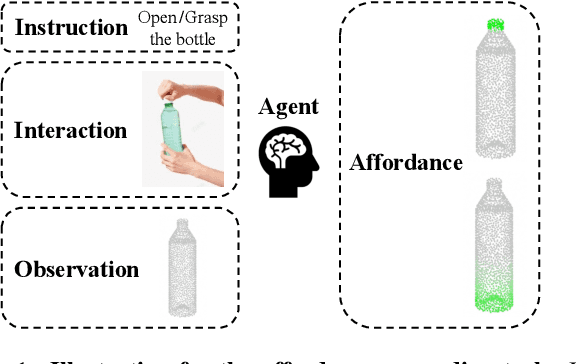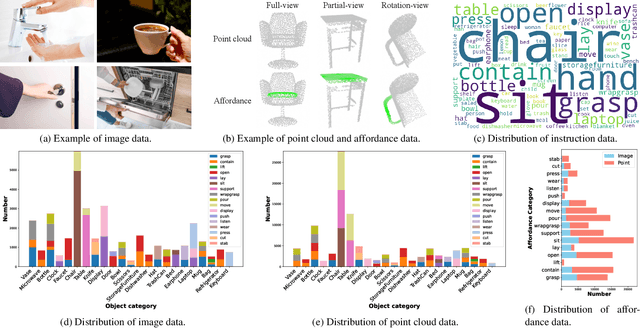Rong Xiong
BEV-ODOM2: Enhanced BEV-based Monocular Visual Odometry with PV-BEV Fusion and Dense Flow Supervision for Ground Robots
Sep 18, 2025Abstract:Bird's-Eye-View (BEV) representation offers a metric-scaled planar workspace, facilitating the simplification of 6-DoF ego-motion to a more robust 3-DoF model for monocular visual odometry (MVO) in intelligent transportation systems. However, existing BEV methods suffer from sparse supervision signals and information loss during perspective-to-BEV projection. We present BEV-ODOM2, an enhanced framework addressing both limitations without additional annotations. Our approach introduces: (1) dense BEV optical flow supervision constructed from 3-DoF pose ground truth for pixel-level guidance; (2) PV-BEV fusion that computes correlation volumes before projection to preserve 6-DoF motion cues while maintaining scale consistency. The framework employs three supervision levels derived solely from pose data: dense BEV flow, 5-DoF for the PV branch, and final 3-DoF output. Enhanced rotation sampling further balances diverse motion patterns in training. Extensive evaluation on KITTI, NCLT, Oxford, and our newly collected ZJH-VO multi-scale dataset demonstrates state-of-the-art performance, achieving 40 improvement in RTE compared to previous BEV methods. The ZJH-VO dataset, covering diverse ground vehicle scenarios from underground parking to outdoor plazas, is publicly available to facilitate future research.
Toward Embodiment Equivariant Vision-Language-Action Policy
Sep 18, 2025Abstract:Vision-language-action policies learn manipulation skills across tasks, environments and embodiments through large-scale pre-training. However, their ability to generalize to novel robot configurations remains limited. Most approaches emphasize model size, dataset scale and diversity while paying less attention to the design of action spaces. This leads to the configuration generalization problem, which requires costly adaptation. We address this challenge by formulating cross-embodiment pre-training as designing policies equivariant to embodiment configuration transformations. Building on this principle, we propose a framework that (i) establishes a embodiment equivariance theory for action space and policy design, (ii) introduces an action decoder that enforces configuration equivariance, and (iii) incorporates a geometry-aware network architecture to enhance embodiment-agnostic spatial reasoning. Extensive experiments in both simulation and real-world settings demonstrate that our approach improves pre-training effectiveness and enables efficient fine-tuning on novel robot embodiments. Our code is available at https://github.com/hhcaz/e2vla
TOP: Time Optimization Policy for Stable and Accurate Standing Manipulation with Humanoid Robots
Aug 01, 2025Abstract:Humanoid robots have the potential capability to perform a diverse range of manipulation tasks, but this is based on a robust and precise standing controller. Existing methods are either ill-suited to precisely control high-dimensional upper-body joints, or difficult to ensure both robustness and accuracy, especially when upper-body motions are fast. This paper proposes a novel time optimization policy (TOP), to train a standing manipulation control model that ensures balance, precision, and time efficiency simultaneously, with the idea of adjusting the time trajectory of upper-body motions but not only strengthening the disturbance resistance of the lower-body. Our approach consists of three parts. Firstly, we utilize motion prior to represent upper-body motions to enhance the coordination ability between the upper and lower-body by training a variational autoencoder (VAE). Then we decouple the whole-body control into an upper-body PD controller for precision and a lower-body RL controller to enhance robust stability. Finally, we train TOP method in conjunction with the decoupled controller and VAE to reduce the balance burden resulting from fast upper-body motions that would destabilize the robot and exceed the capabilities of the lower-body RL policy. The effectiveness of the proposed approach is evaluated via both simulation and real world experiments, which demonstrate the superiority on standing manipulation tasks stably and accurately. The project page can be found at https://anonymous.4open.science/w/top-258F/.
Grounding 3D Object Affordance with Language Instructions, Visual Observations and Interactions
Apr 07, 2025



Abstract:Grounding 3D object affordance is a task that locates objects in 3D space where they can be manipulated, which links perception and action for embodied intelligence. For example, for an intelligent robot, it is necessary to accurately ground the affordance of an object and grasp it according to human instructions. In this paper, we introduce a novel task that grounds 3D object affordance based on language instructions, visual observations and interactions, which is inspired by cognitive science. We collect an Affordance Grounding dataset with Points, Images and Language instructions (AGPIL) to support the proposed task. In the 3D physical world, due to observation orientation, object rotation, or spatial occlusion, we can only get a partial observation of the object. So this dataset includes affordance estimations of objects from full-view, partial-view, and rotation-view perspectives. To accomplish this task, we propose LMAffordance3D, the first multi-modal, language-guided 3D affordance grounding network, which applies a vision-language model to fuse 2D and 3D spatial features with semantic features. Comprehensive experiments on AGPIL demonstrate the effectiveness and superiority of our method on this task, even in unseen experimental settings. Our project is available at https://sites.google.com/view/lmaffordance3d.
UnIRe: Unsupervised Instance Decomposition for Dynamic Urban Scene Reconstruction
Apr 01, 2025Abstract:Reconstructing and decomposing dynamic urban scenes is crucial for autonomous driving, urban planning, and scene editing. However, existing methods fail to perform instance-aware decomposition without manual annotations, which is crucial for instance-level scene editing.We propose UnIRe, a 3D Gaussian Splatting (3DGS) based approach that decomposes a scene into a static background and individual dynamic instances using only RGB images and LiDAR point clouds. At its core, we introduce 4D superpoints, a novel representation that clusters multi-frame LiDAR points in 4D space, enabling unsupervised instance separation based on spatiotemporal correlations. These 4D superpoints serve as the foundation for our decomposed 4D initialization, i.e., providing spatial and temporal initialization to train a dynamic 3DGS for arbitrary dynamic classes without requiring bounding boxes or object templates.Furthermore, we introduce a smoothness regularization strategy in both 2D and 3D space, further improving the temporal stability.Experiments on benchmark datasets show that our method outperforms existing methods in decomposed dynamic scene reconstruction while enabling accurate and flexible instance-level editing, making it a practical solution for real-world applications.
Disambiguate Gripper State in Grasp-Based Tasks: Pseudo-Tactile as Feedback Enables Pure Simulation Learning
Mar 31, 2025Abstract:Grasp-based manipulation tasks are fundamental to robots interacting with their environments, yet gripper state ambiguity significantly reduces the robustness of imitation learning policies for these tasks. Data-driven solutions face the challenge of high real-world data costs, while simulation data, despite its low costs, is limited by the sim-to-real gap. We identify the root cause of gripper state ambiguity as the lack of tactile feedback. To address this, we propose a novel approach employing pseudo-tactile as feedback, inspired by the idea of using a force-controlled gripper as a tactile sensor. This method enhances policy robustness without additional data collection and hardware involvement, while providing a noise-free binary gripper state observation for the policy and thus facilitating pure simulation learning to unleash the power of simulation. Experimental results across three real-world grasp-based tasks demonstrate the necessity, effectiveness, and efficiency of our approach.
Natural Humanoid Robot Locomotion with Generative Motion Prior
Mar 12, 2025Abstract:Natural and lifelike locomotion remains a fundamental challenge for humanoid robots to interact with human society. However, previous methods either neglect motion naturalness or rely on unstable and ambiguous style rewards. In this paper, we propose a novel Generative Motion Prior (GMP) that provides fine-grained motion-level supervision for the task of natural humanoid robot locomotion. To leverage natural human motions, we first employ whole-body motion retargeting to effectively transfer them to the robot. Subsequently, we train a generative model offline to predict future natural reference motions for the robot based on a conditional variational auto-encoder. During policy training, the generative motion prior serves as a frozen online motion generator, delivering precise and comprehensive supervision at the trajectory level, including joint angles and keypoint positions. The generative motion prior significantly enhances training stability and improves interpretability by offering detailed and dense guidance throughout the learning process. Experimental results in both simulation and real-world environments demonstrate that our method achieves superior motion naturalness compared to existing approaches. Project page can be found at https://sites.google.com/view/humanoid-gmp
Efficient Alignment of Unconditioned Action Prior for Language-conditioned Pick and Place in Clutter
Mar 12, 2025Abstract:We study the task of language-conditioned pick and place in clutter, where a robot should grasp a target object in open clutter and move it to a specified place. Some approaches learn end-to-end policies with features from vision foundation models, requiring large datasets. Others combine foundation models in a zero-shot setting, suffering from cascading errors. In addition, they primarily leverage vision and language foundation models, focusing less on action priors. In this paper, we aim to develop an effective policy by integrating foundation priors from vision, language, and action. We propose A$^2$, an action prior alignment method that aligns unconditioned action priors with 3D vision-language priors by learning one attention layer. The alignment formulation enables our policy to train with less data and preserve zero-shot generalization capabilities. We show that a shared policy for both pick and place actions enhances the performance for each task, and introduce a policy adaptation scheme to accommodate the multi-modal nature of actions. Extensive experiments in simulation and the real-world show that our policy achieves higher task success rates with fewer steps for both pick and place tasks in clutter, effectively generalizing to unseen objects and language instructions.
CarPlanner: Consistent Auto-regressive Trajectory Planning for Large-scale Reinforcement Learning in Autonomous Driving
Feb 27, 2025Abstract:Trajectory planning is vital for autonomous driving, ensuring safe and efficient navigation in complex environments. While recent learning-based methods, particularly reinforcement learning (RL), have shown promise in specific scenarios, RL planners struggle with training inefficiencies and managing large-scale, real-world driving scenarios. In this paper, we introduce \textbf{CarPlanner}, a \textbf{C}onsistent \textbf{a}uto-\textbf{r}egressive \textbf{Planner} that uses RL to generate multi-modal trajectories. The auto-regressive structure enables efficient large-scale RL training, while the incorporation of consistency ensures stable policy learning by maintaining coherent temporal consistency across time steps. Moreover, CarPlanner employs a generation-selection framework with an expert-guided reward function and an invariant-view module, simplifying RL training and enhancing policy performance. Extensive analysis demonstrates that our proposed RL framework effectively addresses the challenges of training efficiency and performance enhancement, positioning CarPlanner as a promising solution for trajectory planning in autonomous driving. To the best of our knowledge, we are the first to demonstrate that the RL-based planner can surpass both IL- and rule-based state-of-the-arts (SOTAs) on the challenging large-scale real-world dataset nuPlan. Our proposed CarPlanner surpasses RL-, IL-, and rule-based SOTA approaches within this demanding dataset.
BEV-DWPVO: BEV-based Differentiable Weighted Procrustes for Low Scale-drift Monocular Visual Odometry on Ground
Feb 27, 2025Abstract:Monocular Visual Odometry (MVO) provides a cost-effective, real-time positioning solution for autonomous vehicles. However, MVO systems face the common issue of lacking inherent scale information from monocular cameras. Traditional methods have good interpretability but can only obtain relative scale and suffer from severe scale drift in long-distance tasks. Learning-based methods under perspective view leverage large amounts of training data to acquire prior knowledge and estimate absolute scale by predicting depth values. However, their generalization ability is limited due to the need to accurately estimate the depth of each point. In contrast, we propose a novel MVO system called BEV-DWPVO. Our approach leverages the common assumption of a ground plane, using Bird's-Eye View (BEV) feature maps to represent the environment in a grid-based structure with a unified scale. This enables us to reduce the complexity of pose estimation from 6 Degrees of Freedom (DoF) to 3-DoF. Keypoints are extracted and matched within the BEV space, followed by pose estimation through a differentiable weighted Procrustes solver. The entire system is fully differentiable, supporting end-to-end training with only pose supervision and no auxiliary tasks. We validate BEV-DWPVO on the challenging long-sequence datasets NCLT, Oxford, and KITTI, achieving superior results over existing MVO methods on most evaluation metrics.
 Add to Chrome
Add to Chrome Add to Firefox
Add to Firefox Add to Edge
Add to Edge